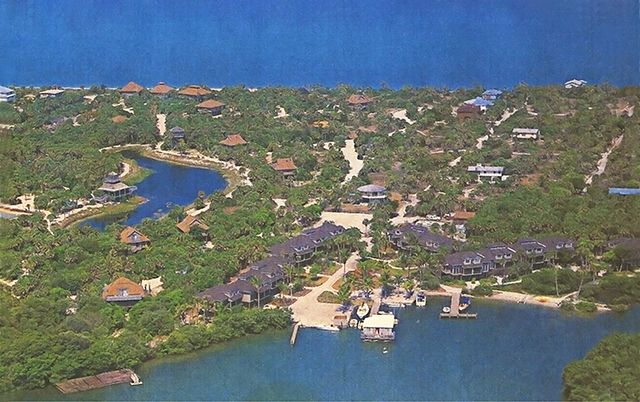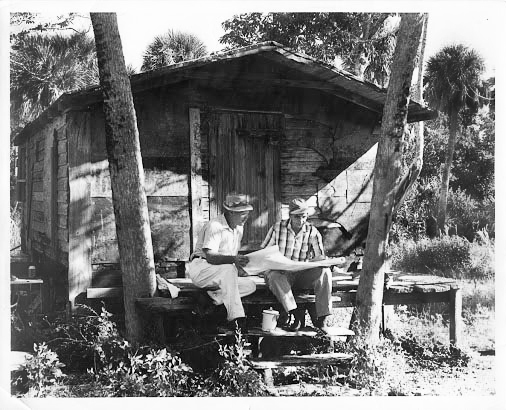Like most people who grew up in Lee County, Florida Gulf Coast University senior Hailey Kerr dug her toes into the sugary sands of local islands like Sanibel from time to time. Now, thanks to a research project involving students, faculty and community members, she’s digging into the history of an island formed 100 years ago by a powerful hurricane.
Through an internship, Kerr collaborates with other students under Rowan Steineker, assistant professor of history, to compile a digital archive preserving the history of Upper Captiva Island. Until 1921, it was part of Captiva Island. That year, an unnamed tempest tore open a new channel across Captiva, creating a separate, bridgeless landmass that came to be called Upper Captiva. Although it can only be reached by water or air, development beginning in the 1980s lured adventurous year-round residents, vacation renters seeking unbeaten paths and hungry boaters docking at harborside restaurants.

Kerr hasn’t actually set foot on the barrier island’s shores yet. But scanning historical photos and other documents and listening to islanders’ oral histories have done more than hone resume-enhancing skills.
“I’ve also gotten a lot more interested in local history since I got involved in the project,” says Kerr, who is double majoring in history and criminal justice. “What I’ve learned is that Upper Captiva is very community oriented and has been for most of its history – very interested in not only preserving history but the environment on the island. I’m really glad to have learned more about it and about local history in general.”
That’s a win for FGCU’s efforts to engage students with the local community and give them hands-on research opportunities, boosting graduate school prospects and career potential.
Lee County’s islands harbor a colorful and sometimes violent past. Calusa tribal members and then Spanish conquistadors paddled to their shores hundreds of years before pleasure-seeking snowbirds and vacationers “discovered” them. Local lore has long conjured images of pirates holding captives on island outposts – hence the name Captiva. Hurricanes have also dramatically shaped and reshaped the islands over time. The 100th anniversary of Upper Captiva’s brutal birth spurred island community members to reach out to FGCU’s history department in 2021.

Steineker and associate professor Frances Davey soon got their students involved in recording oral histories, digitizing and compiling metadata for important documents and photos, and creating a timeline that will become part of a collection housed in FGCU’s Archives and Special Collections.
“It has been a great opportunity to engage our students in hands-on public history work and to collaborate with the community to help them document and preserve their history,” Steineker says. “There was strong interest on the part of community members to further research the history. A lot of island residents who had been there in critical phases were getting older or moving away, and they wanted to be sure their stories were collected and preserved.”
Their efforts will help construct a narrative for Upper Captiva that adds a colorful chapter to regional history, she says. Key turning points include infrastructure building, real estate development and conservation efforts. Outside the realm of human intervention are the impacts of natural disasters like 2004’s Hurricane Charley, a category 4 storm that blasted over the island, shredding homes and nearby mangrove islands.
Only a handful of rustic houses clung to the lush island paradise before development started in the early 1980s. The state had purchased about three-quarters of the island for preservation in the late 1970s, and the cost of barging construction materials to the remote site further limited development.
Today there are 362 houses – mostly vacation rentals, according to Bill Byrnes, chairperson of the Upper Captiva Fire Protection and Rescue Services Board. He’s a retired firefighter on the island who reached out to FGCU and sparked the collaboration. Lee County Electric Cooperative sank the first underwater power lines to the island from Captiva in 1983, he says, the same year Safety Harbor Club started building a condo community. Utilities and housing developments paved the way for million-dollar multistory stilt homes – but no roads.
Aside from shell collecting, fishing and sunbathing, the island’s restaurants provide some diversion amid the isolation. One of the first, Barnacle Phil’s, arrived in the early ‘80s when pioneering developer Phil Kinsey converted a cottage into a harborside seafood shack that gained fame for his wife’s black beans and yellow rice. The Florida native and veteran pilot was inspired to buy property in the early 1960s after flying over the island in his private plane.
His is just one of the stories woven into the tapestry of Upper Captiva history. Preserving that past before it’s lost means a great deal to the islanders, Barnes says.
“We are so grateful to the professors and students,” he says. “They’re very enthusiastic about getting to do something no one has ever done before, tell the history of Upper Captiva. It’s something to be very proud of.”